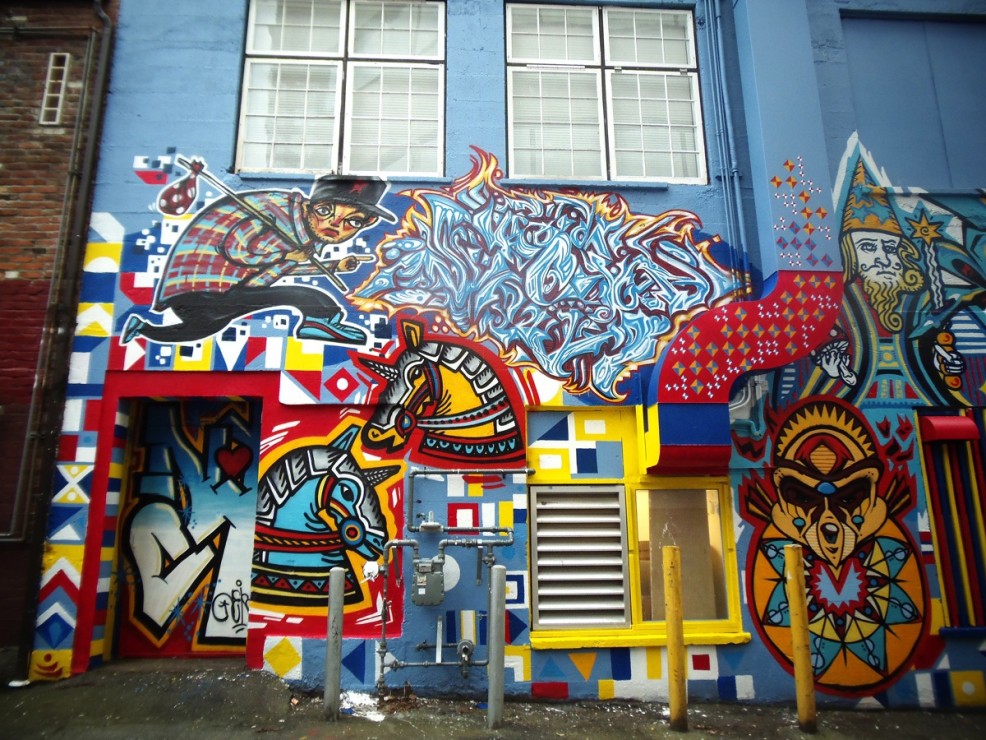
This June Open Space partnered with the City of Victoria to host exhibits on panels in Commercial Alley. It launched with four panels by the renowned street artist Other (aka Troy Lovegates). The next exhibit, Bird Quartet by Roy Green, will be installed August 15. –Emily Thiessen (photo)
For years the channel that starts at Bastion Square, runs through Helmcken Alley, and opens onto Fort Street has been a battleground between graffiti writers and paint rollers. Last year, the City of Victoria sent Open Space a ticket for failing to remove the graffiti on the back wall of their Fort Street art gallery. The ticket falls under a bylaw requiring property owners to pay up to $200 for failing to remove “unsightly conditions”.
Gallery staff thought about what to do; Open Space is non-profit artist-run centre and whitewashing the wall would have been utterly out of character. So like any good arts organization would do in a contentious situation, they made a project out of it, and Open Space director Helen Marzolf wrote to the city to ask for an extension.
Their first graffiti-response project was to invite musicians to play the graffiti as if it were a score. Then they wheat pasted the back wall with photocopies of documents from the Open Space archives. This March they took down the wheat paste and artist-in-residence Cameron Kidd started a mural. After a base layer was finished, the mural was opened to any community members who wanted to contribute – as long as they followed a scheme of primary colours. The result is a masterpiece teetering between anarchic and organized; a deliberate dance in the the gray zone between sanctioned and unsanctioned public art.
[pullquote]Far from being a free for all, the street art community is a culture full of self-governance. [/pullquote]
As curatorial assistant Sarah Fruchtman points out, “The difference between sanctioned and unsanctioned art is not just a question of legality. It’s more a question of what kinds of artworks get funding from the city or get legitimized by an official body.” It’s also a difference between the art that is accepted and celebrated by the community and art that incites the enthusiasm of volunteer graffiti-removal teams. Some pieces do both at once.
As well, bylaws are not the only rules regulating graffiti. Far from being a free for all, the street art community is a culture full of self-governance. For example, the north side of the Wildfire Bakery on Quadra Street is a “free wall”, but you can only paint there on Sundays.
Another example of this dance between municipal and community rules can be found at the Trackside gallery in Esquimalt. In the 1990s the back of a warehouse bordering the E&N Railway was used as a massive open wall for graffiti artists and local kids. “The Tracks” were a gray zone. Nobody seemed to mind the graffiti, but it wasn’t actually legal either. In the early 2000s the city of Esquimalt helped to launch the “Trackside gallery,” a project to clean up the space, add lights, and install panels of art above the ground-level graffiti. However, the police presence and lack of consultation disempowered the street art community and the project fell apart without maintenance. Then one year the graffiti was painted over without warning. “No one painted there ever again,” says Cameron Kidd.
The film 100 Layers of Beige, which premiered at Open Space in April, tells the story of the Trackside gallery. “Graffiti is one of the biggest art movements that ever happened. It is thriving all over the world,” says director Kay Gallivan “To me, one really interesting thing about graffiti is how it plays with ownership of space. A lot of anti-graffiti groups use language like ‘we are protecting the community from vandalism’ when really, at least in the case of the Trackside gallery, the murals were painted and appreciated by community members.”
There was a brief push in 2010 to revive the Trackside gallery but the issue has faded since then. The question lingers: does the Victoria street art community hang on to the memory of this vast free wall, or does it make do with smaller spaces like north wall of the Wildfire bakery? Do we push for more curated murals or take the gates off the graffiti alleys? There is no shortage of walls in the city, the question is only where to start.
Note: A version of this article appears in print on August 14 under the headline: Public art in Victoria.








